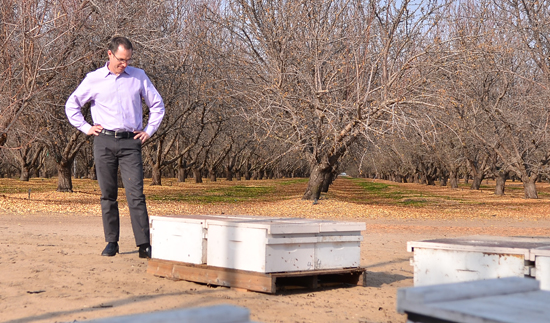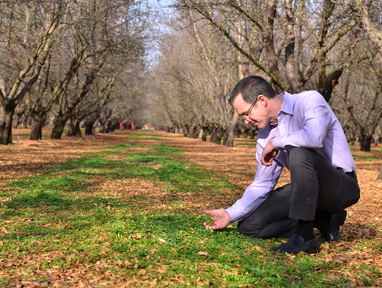California Agricultural Technology Institute
Fresno State entomologist aims to improve health of honeybees
Study seeks to determine if expanded pollen sources will help enhance bee nutrition, reduce devastating effects of Colony Collapse Disorder
A Fresno State entomologist has joined other scientists around the country seeking to improve the health of the nation’s honeybees. Honeybees have been in decline in recent years due to a mysterious malady that is threatening the economic viability of almond growers and other segments of the farming industry that depend on bees to pollinate their crops.
“Almonds are almost exclusively pollinated by honeybees during almond flower bloom,” noted Dr. Andrew Lawson of the Department of Plant Science. Each year in February, one and a half to two million hives are placed in California almond orchards; some hives are trucked in from across the United States to meet the demands of a growing industry.
But since 2006 a so far unknown affliction has invaded hives across the country. Beekeepers have reported losses of up to 30 and 40 percent of their hives. And to this point – no one knows why.
 The affliction has been labeled Colony Collapse Disorder (CCD). It is simply described
as when adult bees abandon the hive all together, leaving behind brood, the queen,
and a few workers and drones.
The affliction has been labeled Colony Collapse Disorder (CCD). It is simply described
as when adult bees abandon the hive all together, leaving behind brood, the queen,
and a few workers and drones.
“The root cause has been the focus of much study, and its cause is still a mystery, although prevailing thought points to multiple stressors placed on the bee colonies, including mites, diseases, pesticides and nutritional deficiencies,” Lawson said.
The mystery is compounded by the disappearance of the bees, so necropsy is not possible to determine cause of death.
With financial support from Project Apis m., a national nonprofit organization supporting the honeybee industry, Lawson has organized a study, set in the central San Joaquin Valley, to learn if expanding natural food sources for bees will help enhance bee health and thus strengthen the colonies.
Bees can suffer nutritional deficiencies as a result of supplemental feedings of high-fructose corn syrup in the period preceding almond bloom, and from collection of pollen and nectar from a monoculture system, Lawson noted. These kinds of deficiencies can lead to reduced hive colony strength and perhaps make the colony susceptible to disease, parasites or infection.
Lawson’s plan is to make alternate food sources available to bees prior to almond bloom to determine if this approach will enhance bee and hive health. In cooperation with several almond growers in the area, Lawson and graduate student Adam Noviki have planted stands of oilseed cover crops in the middle of orchards in different locations in the valley. These oilseed plants typically flower prior to almonds and would provide bees with additional nectar and pollen sources to balance their diet.
 The experiment will include four treatments – one control with no alternate forage
planted, and three others, with rapini, borage and cuphea planted, respectively. The
planted areas will measure 20 by 50 meters. One bee hive will be placed at the ends
of each plot. There will be four replicates of each treatment.
The experiment will include four treatments – one control with no alternate forage
planted, and three others, with rapini, borage and cuphea planted, respectively. The
planted areas will measure 20 by 50 meters. One bee hive will be placed at the ends
of each plot. There will be four replicates of each treatment.
Fresno State Plant Science Professor Andrew Lawson examines new stand of borage forage grass that will be an additional pollen source for honeybees.
Data collection will begin in January when hives are placed in the treatment plots and will continue weekly until the cover crops have completed flowering after almond bloom. As measures of colony health, researchers will monitor pollen composition from pollen traps, and brood and frame counts of the hives. Samples of pollen from the pollen traps will be taken weekly to determine pollen species composition in order to determine where the bees have been foraging.
“This is important as bees should move from pre-bloom forage to almonds when the almonds begin to bloom,” Lawson said. Hives also will be weighed at the beginning of pre-bloom, the beginning of almond bloom, the end of almond bloom, and at the end of the post-almond cover crop bloom. This will allow a general measurement of colony growth including bees, brood, and honey, Lawson said.
The study will continue next year with refined experiments conducted with the top one or two oilseed crops producing the greatest hive strength.
Lawson hopes that providing bees with a greater variety of pollen sources will improve bee health and help to solve the mystery of Colony Collapse Disorder.
“Increasing hive strength and health during almond bloom can increase pollination rates, which is a direct benefit to growers and beekeepers alike,” he said. “Growers may very well enjoy lower pollination fees through the reduced costs of using fewer hives per acre if colony strength is increased. In addition, seeds of these cover crops may be harvested for additional economic return to the grower.”
With experiments occurring this spring and again next year, Lawson expects analysis to be completed in the middle of 2014. Results will be released to the industry at that time.
Partial funding for this work was provided by the California State University Agricultural Research Institute (ARI). For more information, contact Lawson at alawson@csufresno.edu.